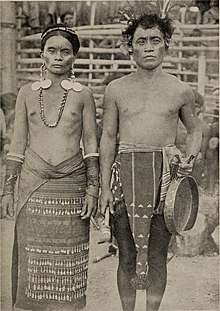 A Kalinga man and woman, 1903 | |
| Total population | |
|---|---|
| 163,167[1] (2010) | |
| Regions with significant populations | |
| Languages | |
| Kalinga, Ilocano, Tagalog | |
| Religion | |
| Christianity, indigenous folk religion, Animism | |
| Related ethnic groups | |
| Igorot peoples |
The Kalinga people[2][3][4] (IPA: [ka'liŋɡa]) are an indigenous ethnic group whose ancestral domain is in the Cordillera Mountain Range of the northern Philippines.[5] They are mainly found in Kalinga province which has an area of 3,282.58 sq. km. Some of them, however, already migrated to Mountain Province, Apayao, Cagayan, and Abra.[6] The Kalinga numbered 163,167 as of 2010.[1]
- ^ a b "2010 Census of Population and Housing, Report No. 2A: Demographic and Housing Characteristics (Non-Sample Variables) - Philippines" (PDF). Philippine Statistics Authority. Retrieved 7 October 2020.
- ^ Scott, William Henry (1996). On the Cordilleras: A look at the peoples and cultures of the Mountain Province. 884 Nicanor Reyes, Manila, Philippines: MCS Enterprises, Inc. p. 16.
{{cite book}}: CS1 maint: location (link) - ^ Masferré, Eduardo; Jill Gale De Villa (1999). A Tribute to the Philippine Cordillera. Asiatype, Inc. ISBN 971-91712-0-0. Retrieved 2008-09-16.
- ^ Molintas, J.S. (2004). "The Philippine Indigenous Peoples' Struggle for Land and Life: Challenging Legal Texts". Arizona Journal of International & Comparative Law. 21 (1): 269–306.
- ^ Bramhall, Donna. "Exploring Kalinga culture, tattoo artistry, tribal traditions". Rappler. Archived from the original on 2021-09-07. Retrieved 2021-09-07.
- ^ Sumeg-ang, Arsenio (2005). "5 The Kalingas". Ethnography of the Major Ethnolinguistic Groups in the Cordillera. Quezon City: New Day Publishers. pp. 115–135. ISBN 9789711011093.